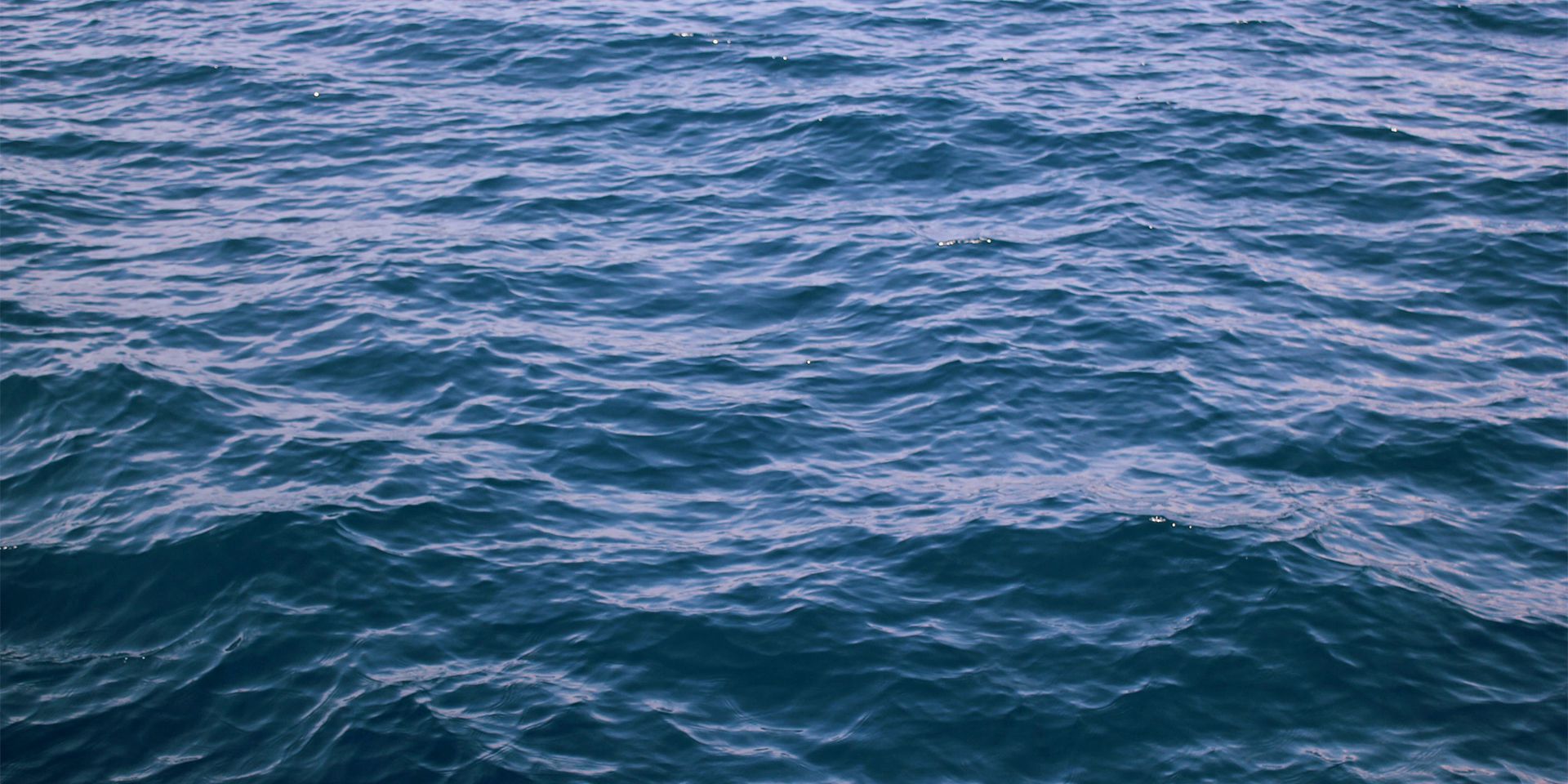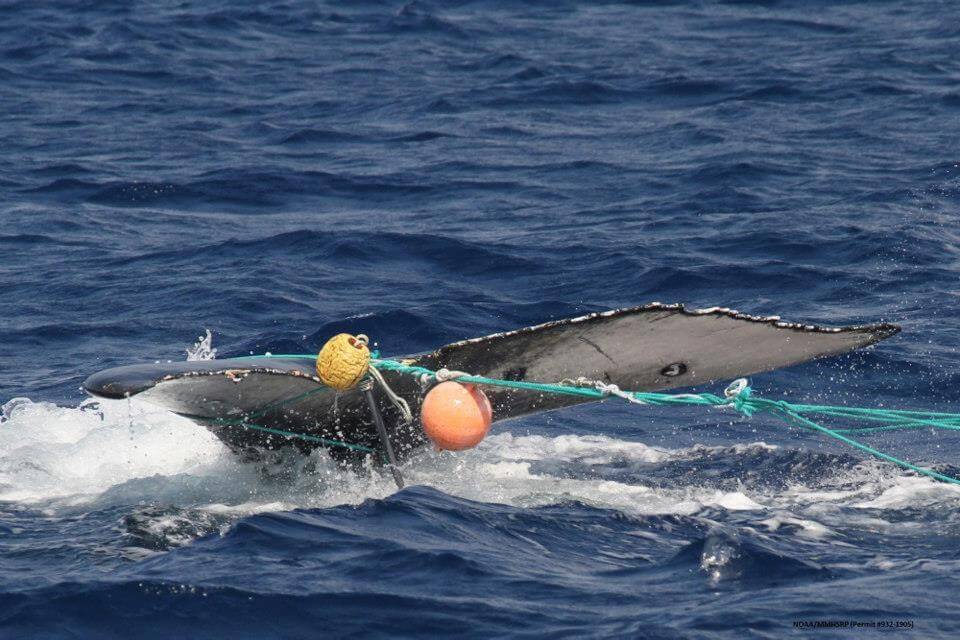1996
Take of right, humpback, and fin whales in various Atlantic coast trap and gillnet fisheries for lobster, crabs, conchs/whelks, groundfish, monkfish, sharks, hagfish, and other finfish.

In 1994, the Marine Mammal Protection Act (MMPA) was amended to establish a system for assessing the status of marine mammal stocks in U.S. waters and reducing their incidental take in commercial fisheries. Those amendments provide the current basis for managing interactions between fisheries and marine mammals. They require the National Marine Fisheries Service (NMFS) and the U.S. Fish and Wildlife Service (FWS) to:

A humpback whale entangled in fishing gear. Photo taken under NOAA MMHSRP permit #932-1905. (NOAA)
NMFS is responsible for the protection and management of all whales, dolphins, and pinnipeds (except walruses) while the FWS is responsible for manatees, sea otters, walruses, and polar bears.
Section 117 of the MMPA requires NMFS and FWS to prepare and periodically update marine mammal stock assessment reports for each stock occurring in U.S. waters under their respective jurisdictions. Each stock assessment report is to describe the geographic range of the stock and estimates of its minimum population size, population trend, current and maximum net productivity rates, and potential biological removal level. The potential biological removal (PBR) level is an estimate of the number of individuals that could be taken as a result of human activities while still allowing the stock to recover to or remain within the envelope of its optimum sustainable population size. PBR is calculated from a stock’s minimum population estimate, maximum net productivity rate, and a recovery factor that is designed to provide additional protection based on the relative status of the stock under consideration and account for uncertainties other than those associated with the abundance estimate. Stock assessment reports also are required to describe for each stock the commercial fisheries it interacts with and the total number of mortalities and serious injuries to marine mammals caused by human activities. Finally, each report must categorize the stock as either ‘strategic’ or ‘not strategic.’ Stocks that are listed as ‘threatened’ or ‘endangered’ under the Endangered Species Act (ESA), or ‘depleted’ under the MMPA, are considered to be ‘strategic’ by default. Other stocks are categorized as ‘strategic’ if estimates of human-caused mortality and serious injury for the stock exceed its PBR level. Comments submitted by the Commission on NMFS Stock Assessment Reports are listed below (see “Learn More” section).
Section 118 of the MMPA requires NMFS to classify each U.S. fishery into one of three categories according to the frequency with which the fishery incidentally kills or seriously injures (referred to here as ‘takes’) marine mammals relative to the PBR level of each of the marine mammal stocks with which the fishery interacts:
The List of Fisheries is reviewed and updated annually. The Marine Mammal Commission provides formal comments and recommendations on the NMFS List of Fisheries (see letters section below).

Entangled Dall’s Porpoise (Phocoenoides dalli). (NOAA)
Section 118 of the MMPA also directs NMFS to prepare a take reduction plan (TRP) for each ‘strategic’ marine mammal stock that interacts with a Category I or Category II fishery. Such plans also may be developed when a Category I fishery has a high level of mortality and serious injury involving one or more marine mammal stocks, even though it does not exceed PBR. Individual TRPs often address multiple marine mammal stocks and fisheries with similar or related incidental take problems. In accordance with the MMPA, the goals of a TRP are to (1) reduce mortality and serious injury to less than a marine mammal stock’s PBR with six months of the plan’s implementation date, and (2) reduce serious injury and mortality to insignificant levels approaching a zero rate within five years. That insignificance threshold is defined by NMFS as less than 10 percent of PBR, or what is known as the zero mortality rate goal (ZMRG).
NMFS uses Take Reduction Teams (TRTs) to develop recommendations for measures to be included in take reduction plans and to monitor the implementation of those plans until NMFS has determined that the goals have been met. Team members include representatives of relevant fisheries, conservation groups, the academic community, fishery management organizations, and involved federal and state agencies. A representative of the Marine Mammal Commission participates on all TRTs. To date, seven TRTs have been established (see table below). The Atlantic Trawl Gear TRT has not met in over a decade, but the rest of the TRTs are still active.
1996
Take of right, humpback, and fin whales in various Atlantic coast trap and gillnet fisheries for lobster, crabs, conchs/whelks, groundfish, monkfish, sharks, hagfish, and other finfish.
1996
Take of short-finned pilot, sperm, pygmy sperm, humpback, and beaked (Cuvier’s, Baird’s, and Mesoplodon spp.) whales in Pacific drift gillnet fisheries for sharks and swordfish.
1997
Take of harbor porpoises in various Atlantic coast set gillnet fisheries for groundfish (e.g., haddock, cod, and flounder), coastal finfish, spiny dogfish, and monkfish.
2001
Take of bottlenose dolphins in various mid-Atlantic set gillnet, trap, seine, and pound-net fisheries for coastal finfish, dogfish, and crabs.
2005
Take of long- and short-finned pilot whales and Risso’s dolphins in Atlantic coast pelagic longline fisheries for swordfish, sharks, and tuna.
2006
Take of long-finned and short-finned pilot whales, common dolphins, and Atlantic white-sided dolphins in Atlantic coast trawl net fisheries for various finfish, squid, and shellfish.
2010
Take of pelagic and insular stocks of false killer whales in Hawaii-based deep-set and shallow-set longline fisheries.
| Letter Date | Letter Description |
|---|---|
| January 24, 2022 | Letter to NMFS with comments on its draft 2021 Stock Assessment Reports |
| September 15, 2021 | Letter to NMFS with comments on its 2022 proposed List of Fisheries |
| March 9, 2021 | Letter to NMFS with comments on its 2020 draft Stock Assessment Reports |
| October 28, 2020 | Letter to NMFS with comments on its 2021 proposed List of Fisheries |
| April 27, 2020 | Letter to FWS with comments on its 2020 draft Stock Assessment Report for the southern sea otter |
| February 25, 2020 | Letter to NMFS with comments on its 2019 draft Stock Assessment Reports |
| November 12, 2019 | Letter to NFMS with comments on its 2020 proposed List of Fisheries |
| November 23, 2018 | Letter to NMFS with comments on its 2019 proposed List of Fisheries |
| April 17, 2018 | |
| February 13, 2017 | |
| December 28, 2016 |